Services on Demand
Journal
Article
Related links
Share
Enfermería: Cuidados Humanizados
Print version ISSN 1688-8375On-line version ISSN 2393-6606
Enfermería (Montevideo) vol.12 no.2 Montevideo 2023 Epub Dec 01, 2023
https://doi.org/10.22235/ech.v12i2.2967
Original articles
Risky sexual behaviours related to sexually transmitted infections in a Shuar community of Taisha, Ecuador
1 Universidad de Cuenca, Ecuador
2 Universidad de Concepción, Chile, osanhue@udec.cl
Objective:
To describe risky sexual behaviours related to sexually transmitted infections (STIs) in a Shuar community of Taisha, Ecuador.
Methodology:
Descriptive-cross-sectional study, based on Leininger's cross-cultural theory. A total of 215 adults of both sexes over 18 years of age participated. A questionnaire validated by experts was used, with Delphi method. The relational analysis used the X2 test.
Results:
Of the sample, 153 women and 62 men, 99.1 % identified themselves as heterosexual; 79.1 % indicated that their sexual activity began in preadolescence, most frequently of the genital type; 16.3 % reported having ever had an STI; 29.3 % had had sexual relations while intoxicated, of which 6 % reported using a condom. The 60 % percent responded that they do not use condoms because they do not know how and because they feel less pleasure; 36.7 % reported having casual sex, 73 % of them without using a condom. There was no significant association between sexual behaviors and age.
Conclusion:
The scarce use of condoms, incidental unprotected sex, early onset and sexual activity under the influence of alcohol or aphrodisiac substances were found to be risk practices for contracting a sexually transmitted infection in this indigenous community. There is a need to build bridges from the health system to the communities to implement prevention, diagnosis and treatment programs in early stages for detection, education, support and control. The transcultural nursing model and the interdisciplinary work allow knowing the principles, values and cosmovision of the community members.
Keywords: sexual behavior; sexually transmitted infections; indigenous peoples; cross-cultural nursing
Objetivo:
Describir conductas sexuales de riesgo relacionadas con las infecciones de transmisión sexual (ITS) en una comunidad shuar de Taisha, Ecuador.
Metodología:
Estudio descriptivo-transversal, con base en la teoría transcultural de Leininger. Participaron 215 adultos de ambos sexos, mayores de 18 años. Se utilizó un cuestionario validado por expertos, con método Delphi. El análisis relacional usó la prueba de X2.
Resultados:
De la muestra, 153 mujeres y 62 hombres, el 99.1 % se identificó como heterosexual; 79.1 % indicó que su actividad sexual se inició en la preadolescencia, siendo lo más frecuente de tipo genital; 16.3 % reveló haber presentado alguna vez una ITS; 29.3 % ha tenido relaciones sexuales bajo efecto del alcohol o sustancias afrodisíacas, de los que 6 % indicó utilizar preservativo. El 60 % respondió que no lo usa porque no sabe cómo y por sentir menos placer; 36.7 % refirió tener relaciones sexuales fortuitas y, en ellas, 73 % sin usar preservativo. No hubo asociación significativa entre las conductas sexuales y la edad de las personas.
Conclusión:
El escaso uso de preservativo, relaciones sexuales fortuitas sin protección, inicio temprano y actividad sexual bajo efecto alcohol o sustancias afrodisíacas resultaron ser prácticas de riesgo para contraer una infección de transmisión sexual en esta comunidad indígena. Se necesita tender puentes, desde el sistema de salud hasta las comunidades, para implementar programas de prevención, diagnóstico y tratamiento en estadios tempranos para detección, educación, apoyo y control. El modelo de enfermería transcultural y el trabajo interdisciplinario permiten conocer los principios, valores y cosmovisión de los integrantes de la comunidad.
Palabras clave: conducta sexual; infecciones de transmisión sexual; pueblos indígenas; enfermería transcultural
Objetivo:
Descrever os comportamentos sexuais de risco relacionados às doenças sexualmente transmissíveis (DST) em uma comunidade shuar em Taisha, Equador.
Metodologia:
Estudo descritivo-transversal, com base na teoria transcultural de Leininger. Participaram 215 adultos de ambos os sexos, com mais de 18 anos de idade. Foi utilizado um questionário validado por especialistas por meio do método Delphi. A análise relacional usou o teste X2.
Resultados:
Da amostra, 153 mulheres e 62 homens, 99,1 % se identificaram como heterossexuais; 79,1% indicaram que sua atividade sexual começou na pré-adolescência, mais frequentemente do tipo genital; 16,3 % revelaram já ter tido uma DST; 29,3 % tiveram relações sexuais sob o efeito de álcool, dos quais 6 % indicaram usar preservativo. Sessenta por cento disseram que não usam preservativos porque não sabem como usar e porque sentem menos prazer; 36,7 % relataram ter feito sexo casual, sendo 73 % deles sem usar preservativo. Não houve associação significativa entre o comportamento sexual e a idade.
Conclusão:
Constatou-se que o baixo uso de preservativos, o sexo casual desprotegido, o início precoce e a atividade sexual sob efeito do álcool ou substâncias afrodisíacas resultaram ser práticas de risco para contrair uma doença sexualmente transmissível nessa comunidade indígena. É necessário construir pontes entre o sistema de saúde e as comunidades para implementar programas de prevenção, diagnóstico e tratamento em estágios iniciais para detecção, educação, apoio e controle. O modelo de enfermagem transcultural e o trabalho interdisciplinar nos permitem conhecer os princípios, os valores e a visão de mundo dos membros da comunidade.
Palavras-chave: comportamento sexual; doenças sexualmente transmissíveis; povos indígenas; enfermagem transcultural
Introduction
Studies related to Indigenous people and sexually transmitted infections (STIs) are scarce in Ecuador, where gaps in the prevention, diagnosis, and treatment of these diseases are acknowledged. 1
Ecuador's population consists of 50.4 % women and 49.6 % men. 2) Its urban population represents 60.43 % of the total national population, with 50 % residing in the Coastal region, 45 % in the Sierra region, 5 % in the Amazon region, and 0.2 % in the Insular region. Among the population, 71.9 % identify as mestizo, 6.1 % as white, 6.8 % as Indigenous, 7.2 % as Afro-Ecuadorian, and 7.4 % as Montubio. 2 Due to their high prevalence of diseases, lack of healthcare services, and high rates of morbidity and mortality, Indigenous peoples are considered a vulnerable population. The risk of contracting and dying from STIs is higher in vulnerable populations, such as Indigenous communities. 3
The nationalities and Indigenous peoples in Ecuador are characterized based on the criteria of self-identification, belonging to a nationality. 4) The Shuar is the most numerous Amazonian community, currently amounting to 120 000 people, and its population is increasing as a result of a high birth rate and an increasingly predominant sedentary way of life. 5
The Technical Secretariat of the Amazon Special Territorial Circumscription and the Ministry of Public Health of Ecuador, report that immunopreventable diseases in the Amazon region, in 2014, accounted for 75.20 %, with pneumonia being the main one. In all the Amazonian provinces, the population with respiratory diseases outnumbered those affected by diarrheal diseases. It is essential to highlight the existence of water and food-borne diseases, primarily due to the poor sewerage and sewage disposal services. These diseases represent 11.6 %, being hepatitis, food poisoning and, to a lesser extent, vector-borne diseases (9.2 %), including dengue and cutaneous leishmaniasis, the most recurrent ones. Chronic malnutrition (height/weight ratio, according to age) in the population under five years of age is 29.58 %, the highest in the country. An indicator associated with the consequences of malnutrition is reflected in respiratory diseases, which, by the year 2018, represented 32.03 % of children under five years of age. 6 STIs were not mentioned in this report.
These sexually transmitted diseases are regarded as a severe public health problem in developing countries, as they represent an immense health and economic burden for the State and pose a significant challenge in the field of sexual and reproductive health. In these countries, there are gaps in the prevention, diagnosis, and treatment of STIs in early stages associated with lower educational levels and the initiation of sexual relations, without using protection, at very early ages. 7 According to the World Health Organization, 7 more than one million people worldwide contract an STI every day, with an estimated annual occurrence of over 340 million cases of these curable infections and at least one million new infections occurring daily. Additionally, in the Americas region, fifty-one million sexually active adolescents and adults (aged 15 to 49) acquired an easily curable STI in 2012. Although 89% of the countries have national surveillance systems for these diseases, the reporting is neither standardized nor uniform, partly due to the limited existence of reliable and low-cost tests. As a result, syndromic diagnosis has been adopted to indicate treatment in Latin American countries. (8
According to the Pan American Health Organization, in Ecuador, in 2015, the mortality rate for communicable diseases corresponded to 76.6 per-100,000 inhabitants, being higher in men than in women (88.7 vs 64.8/100 000 inhabitants) and reported that the cases of HIV (Human Immunodeficiency Virus) in 2016 in Ecuador were 29.7 per 100 000 inhabitants, with no ethnicity considered of in these reports. (9 The Institute for Health Metrics and Evaluation (IHME) of the University of Washington revealed that, in Latin America, Ecuador ranks fifth in terms of HIV cases (3.9 %), 1 existing scarce studies related to Indigenous peoples and sexually transmitted diseases in the Ecuadorian territory. The Department of Statistics of District 14D05 in Taisha Canton reported a total of 287 cases of STIs in 2017. In 2018, this number increased to 371 cases among women and men of ethnic groups.
Sexually transmitted infections (STIs) are a group of infectious diseases that are transmitted from person to person through sexual contact, mainly through vaginal, anal, or oral sex, the use of contaminated needles, and contact with blood. Some of them can even be passed on during pregnancy. 10
These infections cause an enormous morbidity and mortality burden to both developed and resource-limited countries, either directly, in terms of their impact on the quality of life, reproductive health, and children's health, or indirectly, in terms of how they facilitate the sexual transmission of HIV. Moreover, they represent a significant economic and health-related burden on individuals and nations as a whole, as well as a substantial loss of productivity, in particular for developing countries, where economic losses resulting from poor health are significant. 11
From a psychological point of view, said infections represent a stigma, which explains why many people are hesitant to seek help when contracting them, thereby contributing to their proliferation. Most STIs have been associated with promiscuous sexual behaviours, as the population mostly affected were sex workers and those who used their services. At the beginning of the 20th century, the spread of STIs became more evident and dispersed among the younger population. 12
In this study, STI-related sexual behaviours were approached from Leininger's transcultural theory, 13 who developed the Sunrise Model. Its graphical representation describes human beings as entities that cannot be separated from their cultural background and original social structure, worldview, life journey, and environment. In Figure 1 the Sunrise Model is presented, showing each component of the transcultural nursing theory.
This model provided guidance for data collection, mainly regarding socio-demographic characteristics and the worldview surrounding individuals belonging to the cultural group, as well as for the information and the diverse factors related to the specific meanings and expressions presented by the individuals immersed in their own context, relating them to the healthcare to be provided. Right from the beginning of the healthcare relationship, the model enables the incorporation of the various factors it includes, such as technological, religious, and philosophical, social, and cultural values, lifeways, political, legal, economic, and educational factors.
According to some authors, 15,16) studies on Knowledge, Attitudes, and Practices have been used in a variety of different health issues. Sexual practices or behaviours are an individual's actions that respond to a stimulus; in other words, they are the concrete aspect, the action, 16 therefore implying that human beings have diverse ways of living their sexuality and of engaging affectively and sexually with others. As concluded by Brito et al.,17 the perception and construction of Shuar sexual behaviours are directly related to the contact with Western culture. Insufficient knowledge among people about STIs has been identified and this has been related to the increase in the prevalence of these diseases.18,19 This situation results in risky sexual practices such as the refusal to use condoms. 20
Psychosocial problems, such as alcohol consumption, intimate partner violence (especially against women), 20 lower perception of risk, and risky sexual behaviours (such as the refusal to use condoms) 22 are associated with the incidence of STIs, especially within Indigenous communities. 23
In that area, nursing professionals have the sole and essential role in getting to know and understand individuals and their families comprehensively during the health-illness continuum; therefore, they need to be prepared to be competent in providing care to people of different beliefs and lifestyles so as to perform their work effectively and knowledgeably. In short, they need to develop a transcultural type of praxis, 16 which implies providing care in a culturally competent manner.
Methodology
The study was descriptive, cross-sectional, and relational in scope. The assumption was: Knowledge, attitudes and sexual practices regarding sexually transmitted infections (STIs) in a Shuar community are associated with the socio-demographic variables of age, gender, education level, marital status, and occupation.
The Shuar inhabitants of the Taisha community in the parish of Macuma, province of Morona (Ecuador), were the unit of analysis.
The total population consisted of 925 adults of both genders over the age of eighteen, all of whom were residents of the Taisha community, from which an intentional and voluntary sample of 215 adults, including both men and women, of legal age, was drawn in 2021. The inclusion criteria for the study consisted of being over 18 years old, living in the Taisha canton, expressing agreement to be part of the study, and being bilingual. Criteria for exclusion considered individuals with a mental disability that prevented them from providing answers objectively.
For data collection, a Knowledge, Attitudes, and Practices questionnaire 24,25,26 was used, validated by experts’ criteria using the modified Delphi method. 27 Most of the experts agreed on the necessity to improve how the instrument was presented while keeping its structure in the same four sections and recommended adjusting it to the cultural environment by adapting the language (with an emphasis on the wording of the measurement of knowledge about STIs).
The questionnaire is structured in four sections. The first section considers the socio-demographic variables (age, sex, level of education, marital status, and occupation); then, there follows another section regarding knowledge, a third one regarding attitudes and a fourth on the participant’s behaviour’s regarding sexually transmitted diseases. This last area consists of twelve questions, with closed-ended answers, related to the sexual habits and practices of the respondents. The collected data was organised in a Microsoft Excel spreadsheet that was subsequently imported into SPSS statistical software version 23.0. Statistical processing at a descriptive level was conducted by analysing absolute and relative frequencies (percentages). The relationship between the variables was established through the non-parametric inferential X 2 test, as appropriate according to the type of variable. The results were summarised in tables. The research process was carried out with the consent of the political chief of the Taisha canton, who issued a letter granting permission to have unrestricted access to the community. The community was then approached by means of home visits to obtain individual informed consent, always considering aspects related to privacy and respect for the participants. Three Ethics Committees evaluated and approved the study, including the Bioethics Committee of the University of Cuenca, Ecuador.
Results
The sample of the study consisted of 215 Shuar participants from a Taisha community in Ecuador. The profile of the sample is presented below in Figures 2,3, 4, 5,6.
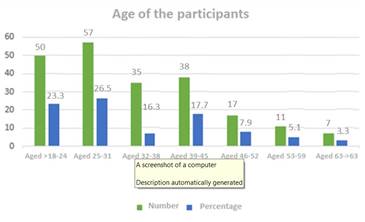
Figure 2: Socio-demographic characteristics of 215 people from a Taisha community according to age. Morona, Ecuador, 2021

Figure 3: Socio-demographic characteristics of 215 people from a Taisha community according to gender. Morona, Ecuador, 2021

Figure 4: Socio-demographic characteristics of 215 people from a Taisha community according to marital status. Morona, Ecuador, 2021
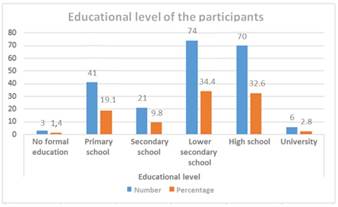
Figure 5: Socio-demographic characteristics of 215 people from a Taisha community according to educational level. Morona, Ecuador, 2021

Figure 6: Socio-demographic characteristics of 215 people from a Taisha community according to occupation. Morona, Ecuador, 2021
Figures 2 to 6 show that the most representative age group was 25 to 31 years old, which was followed by an equal proportion of people between 18 and 24 years old; 3 out of 10 participants were in that age group, 7 out of 10 were female, 5 out of 10 were married, and 5 out of 10 participants had elementary and high school education. The participants’ main occupation was homemaker, followed by being a farmer.
Table 1: Characterisation of sexual behaviours according to gender: number of sexual partners in a Taisha community in Morona, Ecuador 2021. n = 215

Source: Jiménez Brito & Sanhueza-Alvarado, 2022 28
The study showed that, during the previous 12 months, people had engaged in sexual intercourse with 1 to 10 partners (84.5 %), and, it also revealed that, in the same period, 6.9 % of men had had sexual relations with 11 to 20 partners.
Table 2: Characterisation of sexual behaviours based on gender: age of onset of sexually active life in a Taisha community in Morona, Ecuador 2021. n = 215

Source: Jiménez Brito & Sanhueza-Alvarado, 2022 (28)
Most participants indicated that their onset of sexual activity occurred between the ages of 14 and 16 years old, proportionally for both males and females, with only a small percentage of individuals who became sexually active after the age of nineteen.
Table 3: Behaviours related to sexually transmitted diseases in a Taisha community in Morona, Ecuador 2021. n = 215
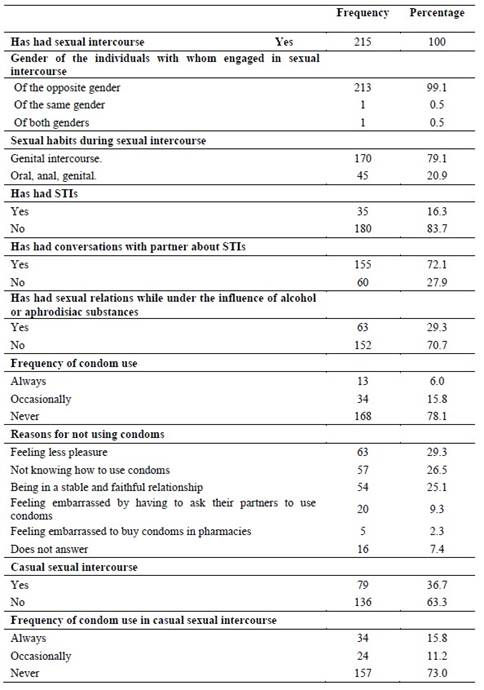
Source: Jiménez Brito & Sanhueza-Alvarado, 2022 28
Most of the participants identified themselves as heterosexual with 8 out of 10 stating that they engage in genital sex; 2 out of 10 indicated having had an STI, 3 out of 10 reported having had sex while under the influence of alcohol, only 6 % indicated always using condoms, while 6 out of 10 reported not using condoms for not knowing how to use them and because they perceive reduced pleasure. On the other hand, 4 out of 10 respondents reported having casual sexual intercourse, and in such casual encounters, only 2 out of 10 indicated using condom protection.
Table 4: Relationships between sexual behaviour and age of individuals in a Taisha community in Morona, Ecuador 2021. n = 215
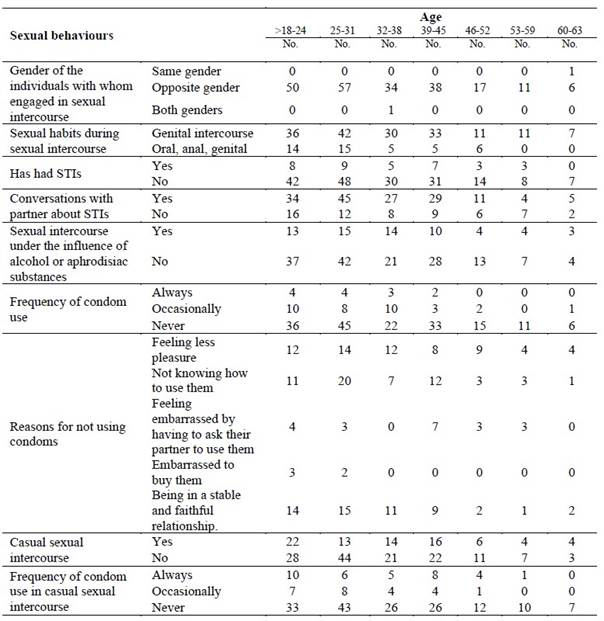
Source: Jiménez Brito & Sanhueza-Alvarado, 2022 (28)
There was no significant association between sexual behaviour and the age of the individuals. It was observed that almost 100% of respondents reported having sexual relations with the opposite sex, and genital intercourse was the most frequently mentioned option by all age groups. As to whether they have had STIs, most of the answers were negative, even though in all the age groups, some individuals did experience STIs, particularly between the ages of 18 and 45, but only in low percentages. Conversations about STIs with their partners were also observed between the ages of 18 and 45, and those over 45 years old were the least likely to engage in such conversations. People between 18 and 45 years of age were the ones who used condoms the least. The study identified the main reasons, in all age groups, for not using condoms, which include feeling less pleasure and not knowing how to use them, as well as being involved in a stable and faithful relationship with a partner. When asked about having had casual sexual intercourse, the negative answer was predominant among all the age groups, although the positive answer was also observed. On the question of whether they use condoms in these casual encounters, most of the respondents responded negatively, indicating that they do not use condoms.
Table 5: Sexual behaviours based on gender in a Taisha community in Morona, Ecuador 2021. n = 215
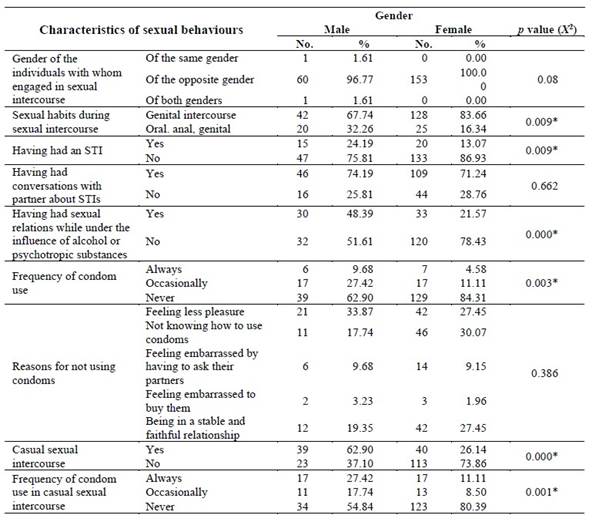
Source: Jiménez Brito & Sanhueza-Alvarado, 2022 28
In Table 5, the X 2 test made it possible to find a significant association between the gender of the individuals and some sexual practices:
- Form of engaging in sexual intercourse: Women tended to have genital intercourse predominantly.
- Having had an STI: Men have acquired STIs more.
- Having had sexual relations while under the influence of alcohol or aphrodisiac substances: women had a lower frequency of use.
- Frequency of condom use: A high percentage of female respondents reported never using condoms, which may suggest that they demand its use less.
- Casual sexual intercourse: Men were more likely to engage in casual sexual encounters.
- Condom use in casual sexual intercourse: Men were slightly more likely to use condoms when engaging in casual sex.
Table 6: Sexual practices according to marital status in a Taisha community in Morona, Ecuador 2021. n = 215
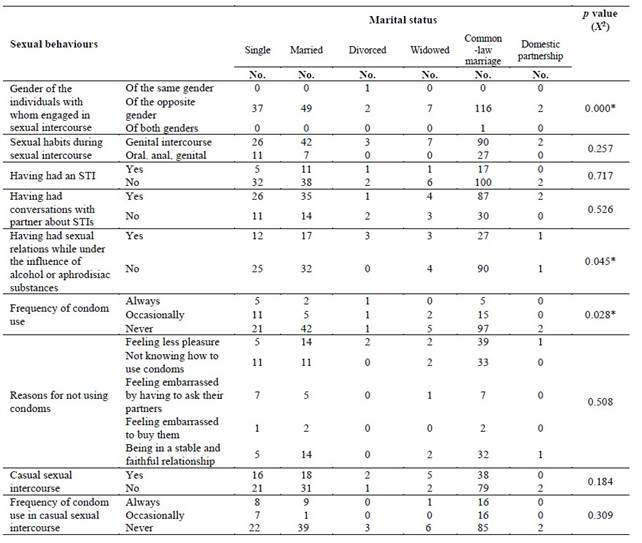
Source: Jiménez Brito & Sanhueza-Alvarado, 2022 28
Table 6 shows that participants’ marital status was significantly associated with the following sexual practices:
- Gender of partners with whom they engaged in sexual intercourse (p=0.000): Bisexual and homosexual practices were only reported by one individual for each case.
- Having sexual intercourse under the influence of alcohol (p=0.045): Those in a Common-law marriage were the least likely to engage in sexual intercourse while intoxicated.
- Frequency of condom use (p=0.028): Single people were more likely to use condoms.
Table 7: Sexual behaviours according to education level in a Taisha community in Morona, Ecuador 2021. n = 215
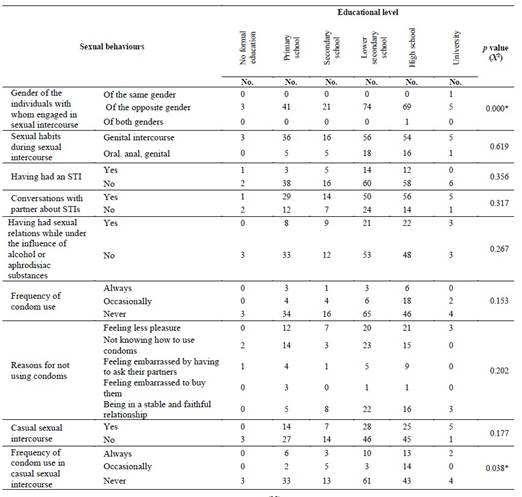
Source: Jiménez Brito & Sanhueza-Alvarado, 2022 (28)
Table 7 shows that the level of education among the participants was statistically associated only with sexual practices related to:
- Gender of the persons with whom they had sexual relations: almost all respondents selected heterosexual activity.
- Use of condoms when engaging in casual sexual intercourse: a tendency for lower levels of education to be less likely to use this method of protection is shown.
Table 8: Sexual behaviours according to occupation in a Taisha community in Morona, Ecuador 2021. n = 215

Source: Jiménez Brito & Sanhueza-Alvarado, 2022 28
In Table 8, the X 2 statistic makes it possible to find a significant association between the occupation of individuals and certain sexual practices and it was revealed that:
- Habits during sexual intercourse: it was more common for those who did not work, for masons, and for farmers to admit that they had different types of sexual intercourse with their partners.
- Sexual intercourse under the influence of alcohol or aphrodisiac substances: it was less frequent among homemakers.
- Frequency of condom use: it was higher among those who did not work.
- Condom use in casual sexual intercourse: it was more frequent among masons and those who were unemployed.
Discussion
The results of this study confirm the adequacy of the use of M. Leininger's transcultural theory, 14 as it makes it possible to identify the worldview within the specific context of individuals, in this case, that of the Shuar cultural group, understanding the specific meanings and expressions that individuals of this ethnicity held. Furthermore, this theory provided an understanding of cultural subgroups by recognising the Shuar community as a group that cannot be separated from its context, cultural background, or social structure. It offers valuable information for the establishment of culturally competent care strategies. It can be considered a theory for dealing with specific social groups in the healthcare field, in this case, with the Shuar ethnic group, to provide culturally competent care by taking into consideration their own culture, structure and worldview.
The findings bear similarities to those found in the research conducted by Rufino, 29 particularly in terms of the age range of people between 20 and 30, and the fact that the participants' educational level was predominantly primary school.
With regards to the number of sexual partners in this study, there are similarities to the research conducted by Jiménez Brito et al., 30 in that most of the participants reported having maintained sexual relations with between one to ten partners in the previous twelve months, and there are even some cases where respondents reported having had between 20 to 40 sexual partners. Moreover, the study revealed that most of the participants initiated their sexually active lives between the ages of 14 and 19. This is in line with the findings of De Waard’s study, 31) where the mean age of sexual onset was reported to be around 16.45 ± 3.76 years of age. This age of onset, when compared to non-ethnic groups, differs from what has been found in young people in Quito, Ecuador, 32 where the distribution of sexual initiation changes as age progresses. Specifically, among the adolescents surveyed therein, where 37.2 % initiated their sexual life between the ages of 13 and 15.24 % between 16 and 18.4 % between 10 and 12 and 39.3 % denied having had sexual relations. Such a difference may be attributed to cultural factors, as sexual aspects are identified and stimulated at an early age in the life of individuals from the Shuar ethnic group.
In terms of sexual behaviour, most of the participants in the present study identified themselves as heterosexual and a high percentage engaged in genital sexual activity. These results are in line with those of Giménez-García et al., 33 who reported in 2020 that nearly 70% of the respondents stated that their sexual practices were with people of the opposite sex. These results could be attributed to the gender socialisation and patriarchal culture that people of the Shuar ethnic group receive.
Similarly, another study by Giménez-García et al., 34 found that a quarter of respondents reported having had an STI, which is consistent with the present study in terms of both the percentage and prevalence of men. These findings are also in line with those of Russell et al., 35) who mentions that the HIV epidemics in the Warao community in Venezuela and the Chayahuita in Peru seem to be more concentrated in men than in women, which may be attributed to their lifestyles.
This study also revealed that 29.3 % of the participants engaged in sexual activity under the influence of alcohol or aphrodisiac substances and only 6 % of these individuals reported consistently using condoms. Moreover, a significant percentage cited a lack of knowledge regarding proper condom usage and the perception of reduced pleasure as reasons for non-use. Additionally, one-third of the participants referred to engaging in casual sexual intercourse, with a considerable number of them failing to consistently use condom protection in these situations. In this context, this study is related to the research conducted by Ponce (37) in 2017, which showed that 5 % of 2,259 surveyed Indigenous people recognized condom use as a protective measure. However, half of them did not use condoms due to a lack of education on proper usage. It is apparent that women are affected by these decisions, as they do not ask their partners to use condoms. Coupled with a lack of knowledge about methods of preventing STIs, the influence of these sociocultural factors is considered to have a more significant impact on women. 36
Conclusions
It is concluded that the presence of STIs in Indigenous communities is a reality that cannot be ignored, especially by the State and by the health authorities responsible for establishing public policies on preventive actions and, at the same time, for monitoring and treating STIs.
Sexually transmitted diseases constitute a public health problem, particularly in low- and middle-income countries, with a growing number of cases observed among ethnic groups in Latin America, where their own sexual habits and practices, influenced by patriarchal and anthropological customs, contribute to the exacerbation and worsening of the presence of these diseases. The health team must, therefore, give priority to educational interventions in sexual and reproductive health, placing emphasis on the prevention and treatment of STIs within these population groups in view of the severe complications that individuals with said untreated infections may experience. It is important to acknowledge that the customs and practices observed among the interviewed individuals encompass several elements that have a negative impact on the spread of these diseases.
The present study identified risky sexual practices, and the results are consistent with those of other studies, highlighting the need to raise awareness among individuals from ethnic groups in Ecuador, particularly among the Shuar, the largest indigenous population in the country, about the importance of STI prevention and the need to consider their sexual practices, which are often unprotected, especially among men who express non-use of protective measures due to reasons that reflect their culture and a lack of interest in using them.
Due to cultural reasons, the demand for healthcare services at health centres in Ecuador is more frequent among the female population, as were also the responses observed in this study. In Shuar culture, gender roles are clearly defined, with women taking care of the household and engaging in farming and harvesting activities and men being the ones who undertake activities outside the home and, that is why, when visiting homes to conduct the research, most encounters were with women. Therefore, it is necessary to adopt cultural-dialogical strategies so that both men and women perceive that health institutions acknowledge their culture and customs. This approach will enable them to actively participate in the process and take responsibility for self-care of their own health.
It is crucial for the community to be aware that some STIs are curable and have free treatment available through the National Health System of Ecuador, while others are not and can have devastating consequences on their lives, families, and society caused by their physical complications and the psychological and social disorders that will completely affect their health and wellbeing.
The WHO proposition 7 constitutes a basis for the continuation of this study, which includes proposing a comprehensive and cross-cultural intervention for this population for healthcare management, with an emphasis on the prevention of STIs. Specifically, it involves following up on the prevention of STIs and HIV through comprehensive sexual education, which includes the Shuar population and primary healthcare professionals. Additionally, counselling on safer sexual practices, risk reduction, and specific interventions targeted at key population groups, such as these communities, should be implemented.
It is also concluded that there still needs to be more information and research on Indigenous communities in Ecuador, and even more on STIs. This becomes a social responsibility for health researchers, and it is suggested that this line of research should be further pursued in an interdisciplinary manner, as it is an issue that affects the physical, social, and cultural aspects of people's health in a complex and comprehensive way. As a result, it requires government institutions to provide integrated and person-centred responses from the country's healthcare services.
Limitations of the study
Although the sample represented 23 % of the universe, it is worth noting that it may not have provided a representative gender distribution. Women accounted for over 70% of the sample, limiting the ability to gain a complete understanding of men's perspectives. The observed under-representation of men in the sample can be attributed to the patriarchal culture, wherein men work outside the home and women assume domestic roles.
REFERENCES
1. Edición Médica (Internet). Quito: Edición Médica; (sin fecha). Ecuador entre los 5 países con más nuevos contagios de VIH en AL; 2016 ago 03 (citado 2020 oct 21). Disponible en: Disponible en: https://www.edicionmedica.ec/secciones/salud-publica/ecuador-entre-los-5-pa-ses-con-m-s-contagios-nuevos-de-vih-en-sudam-rica-88358 [ Links ]
2. Ecuador EC (Internet). Quito: Ecuadorec; 2023. ¿Cuántos habitantes hay en Ecuador? Población 2023; 2023 (citado 2022 ene 24). Disponible en: Disponible en: https://ecuadorec.com/numero-habitantes-ecuador-poblacion/ [ Links ]
3. Carrero, Y, Bracho, A, García, W, Arguello, M, Silva, C, González, M, et al. Hallazgos citológicos y factores de riesgo asociados a lesión cervical en mujeres pertenecientes a tres etnias indígenas del Estado Zulia. Kasmera (Internet). 2018;46(2):159-169. Disponible en: https://www.redalyc.org/articulo.oa?id=373061528007 [ Links ]
4. Nacionalidades y etnias del Ecuador. Nacionalidades y Etnias del Ecuador (Internet). Ecuador: Blogger. 2013 abr - (citado 2018 oct 1). Disponible en: Disponible en: http://14nacionalidadesy18gruposetnicos.blogspot.com/2013/04/introduccion-un-pais-que-contiene-mas.html [ Links ]
5. Flacso Andes (Internet). El pueblo shuar de la provincia de Morona Santiago (citado 2018 jul 2). Disponible en: http://www.flacsoandes.edu.ec/biblio/catalog/resGet.php?resId=15479 [ Links ]
6. Secretaría Técnica de Circunscripción Territorial Especial Amazónica. Programa de Desarrollo Amazónico mediante la gestión del Fondo Común (Internet). Quito: República del Ecuador; 2023. Disponible en: https://www.secretariadelamazonia.gob.ec/wp-content/uploads/downloads/2023/02/programa_desarrollo_amazonico_fondo_comun_-9-11-22vf-2.pdf [ Links ]
7. Organización Mundial de la Salud. Infecciones de transmisión sexual (Internet); 2021 nov 22 (citado 2017 jun 15). Disponible en: Disponible en: http://www.who.int/mediacentre/factsheets/fs110/es/ [ Links ]
8. Organización Panamericana de la Salud. Plan de acción para la prevención y el control de la Infección por el VIH y las Infecciones de transmisión sexual (Internet); 2016. Disponible en: https://www.paho.org/hq/dmdocuments/2016/CD55-14-s.pdf [ Links ]
9. Organización Panamericana de la Salud/Organización Mundial de la Salud. Indicadores Básicos, Situación de Salud en las Américas 2017 (Internet); 2017 (citado 2018 jul 17). Disponible en: http://iris.paho.org/xmlui/bitstream/handle/123456789/34330/IndBrasicos2017_spa.pdf?sequence=1&isAllowed=y&ua=1 [ Links ]
10. Organización Mundial de la Salud. Infecciones de transmisión sexual (Internet); 2021 (citado 2022 mar 14). Disponible en: Disponible en: https://www.who.int/es/news-room/fact-sheets/detail/sexually-transmitted-infections-(stis) [ Links ]
11. Reyes, G.A.E. Infecciones de transmisión sexual: Un problema de salud pública en el mundo y en Venezuela. Comunidad y Salud (Internet). 2016(citado 2022 mar 12);14(2):63-71. Disponible en: Disponible en: http://ve.scielo.org/scielo.php?script=sci_abstract&pid=S1690-32932016000200008&lng=es&nrm=iso&tlng=es [ Links ]
12. Mandal, A. History of Sexually Transmitted Disease (Internet). (citado 2019 oct 3). Disponible en: https://www.news-medical.net/health/History-of-Sexually-Transmitted-Disease.aspx [ Links ]
13. Castrillón Chamadoira, E. La enfermera transcultural y el desarrollo de la competencia cultural. Cultura de los Cuidados (Internet). 2015 (citado 2018 oct 3);19(42):128-136. doi: doi: 10.14198/cuid.2015.42.11 [ Links ]
14. Fornons Fontdevila, D., Madeleine Leininger: claroscuro trascultural. Index de Enfermería (Internet). 2010 (citado 2022 mar 26);19 (2-3):172-6. Disponible en: Disponible en: https://scielo.isciii.es/scielo.php?script=sci_abstract&pid=S1132-12962010000200022&lng=es&nrm=iso&tlng=es [ Links ]
15. Laza, C., Sánchez, G. Indagación desde los conocimientos, actitudes y prácticas en salud reproductiva femenina: algunos aportes desde la investigación. Enferm. glob. (Internet). 2012;11(26):408-415. doi: 10.4321/S1695-61412012000200025. [ Links ]
16. Gaviria, A. Factores que influyen en los Conocimientos, Actitudes y Prácticas sobre Salud Sexual y Reproductiva en los adolescentes Sector ER 05, Mulliquindil, 2016 (Tesis). Ambato: Universidad Técnica de Ambato; 2016. Disponible en: http://repositorio.uta.edu.ec/bitstream/123456789/24104/1/Gaviria%20Bola%c3%b1os%20Ang%c3%a9lica%20Paola.pdf [ Links ]
17. Brito Roby, LA, Jiménez Brito, DA, Sinche Rivera, EC, Angulo Rosero, AN. Conocimientos y Percepciones vinculadas con el VIH/SIDA en Comunidades Shuar del Ecuador. Ciencia y enfermería (Internet). 2019 (citado 2022 mar 12);25:17. doi: doi: 10.4067/s0717-95532019000100213. [ Links ]
18. Puig Borràs, C., Montalvo, P. Infecciones de transmisión sexual, VIH y Sida: una aproximación a conocimientos, actitudes y prácticas de poblaciones adultas y jóvenes indígenas en las tierras bajas de Bolivia. Desacatos (Internet). 2011 (citado 2020 oct 30); (35):41-58. Disponible en: Disponible en: http://www.scielo.org.mx/scielo.php?script=sci_abstract&pid=S1607-050X2011000100004&lng=es&nrm=iso&tlng=es [ Links ]
19. Capote Rodríguez, A, Ciria Martín, A, García Milian, AJ, Pérez Piñero, JS. Necesidades educativas sobre Infecciones de transmisión sexual en adolescentes de La Habana Vieja. Rev cub salud pública (Internet). 2017 (citado 2022 may 23);43(2):166-79. Disponible en: Disponible en: https://www.scielosp.org/article/rcsp/2017.v43n2/166-179/ [ Links ]
20. Organización Mundial de la Salud. Género y salud (Internet);2018 (citado 2022 may 23). Disponible en: Disponible en: https://www.who.int/es/news-room/fact-sheets/detail/gender [ Links ]
21. Rodríguez, A, Madero, J, López-Pulles, R, Romero, GA, González-Andrade, F. ¿Existen más Infecciones de transmisión sexual en la provincia de Galápagos? Un análisis de los conocimientos, actitudes y prácticas de la sexualidad a nivel local. Revista de la Facultad de Ciencias Médicas(Quito). 2015;40(1):37-51. Disponible en: https://revistadigital.uce.edu.ec/index.php/CIENCIAS_MEDICAS/article/view/1155 [ Links ]
22. Mitchell, C. Ecuador (Internet). 2013 (citado 2017 jun 15). Disponible en: Disponible en: http://www.paho.org/salud-en-las-americas-2012/index.php?option=com_content&view=article&id=40%3Aecuador&catid=21%3Acountry-chapters&Itemid=149&lang=es [ Links ]
23. Ortíz, J, Freire, M, Palacios, E. Percepciones sobre la salud sexual y reproductiva de las mujeres indígenas Kichwas y Shuaras. Ecuador, 2016. Revista de la Facultad de Ciencias Médicas (Internet). 2016 (citado 2017 jun 26);34(2):21-31. Disponible en: Disponible en: http://www.ucuenca.edu.ec/ojs/index.php/medicina/article/view/987 [ Links ]
24. Moreno Preciado, M. Hacia una antropología del cuidar. Index de Enfermería (Internet). 2018 (citado 2022 jun 20);27(3):113-4. Disponible en: Disponible en: https://scielo.isciii.es/scielo.php?script=sci_abstract&pid=S1132-12962018000200001&lng=es&nrm=iso&tlng=es [ Links ]
25. Freire, E. Evaluación y modificación de los conocimientos actitudes y prácticas de los conscriptos de los cuarteles Dávalos y Portete, frente a las Infecciones de transmisión sexual (ITS) y VIH /SIDA (Tesis de Posgrado). Cuenca: Universidad de Cuenca; 2007. Disponible en: http://dspace.ucuenca.edu.ec/bitstream/123456789/25190/1/FREIRE%20SOLANO%20EULALIA%20DEL%20CARMEN.pdf [ Links ]
26. Palacios, M, Sánchez, J. Conocimientos, actitudes y prácticas sobre Infecciones de transmisión sexual en la población LGBTI (Tesis de Pregrado). Cuenca: Universidad de Cuenca; 2018. Disponible en: http://dspace.ucuenca.edu.ec/handle/123456789/29729 [ Links ]
27. Campistrous, L, Rizo, C. Indicadores e investigación educativa. En Metodología de la Investigación Educacional, Desafíos y polémicas actuales. La Habana: Ecimed; 2006, p. 150-164. [ Links ]
28. Jiménez Brito, D, Sanhueza-Alvarado, O. Conocimientos, actitudes y prácticas sexuales relacionadas con las Infecciones de transmisión sexual en una comunidad Taisha de Morona, Ecuador, 2021 (Tesis doctoral). Concepción: Universidad de Concepción; 2022. Disponible en: http://repositorio.udec.cl/jspui/handle/11594/10014 [ Links ]
29. Rufino, AC, Madeiro, A, Trinidad, A, Santos, R, Freitas, I. Sexual practices and health care of women who have sex with women: 2013-2014. Epidemiol Serv Saude. 2018 ;27(4):e2017499. [ Links ]
30. Jiménez Brito, DA, Brito Roby, LA, Sinche Rivera, EC, Angulo Rosero, AN, Estrada Zamora, EM. Estudio Cualitativo: Prácticas Sexuales Relacionadas con el VIH/SIDA en las Comunidades Shuar de la Parroquia SevillaDon Bosco - Morona Santiago, 2017. Rev Med HJCA (Internet). 2019 (citado 2022 jun 14);11(1):20-6. Disponible en: Disponible en: https://revistamedicahjca.iess.gob.ec/ojs/index.php/HJCA/article/view/86 [ Links ]
31. De Waard, J, Del Nogal, B, Chang, S, Hurtado, JL, Inojosa, H, Mérida, M, et al. Factores de riesgo para infección por VIH en indígenas de la etnia warao del Municipio Antonio Díaz, Estado Delta Amacuro, Venezuela. Octubre diciembre 2015. Bol venez infectol (Internet). 2017 (citado 2023 may 1);28(1):55-65. Disponible en: Disponible en: http://fi-admin.bvsalud.org/document/view/8ja4b [ Links ]
32. Bravo Galarza, I. Edad de inicio de vida sexual de los adolescentes de tercero de bachillerato de un colegio laico, un colegio religioso y un colegio militar de la ciudad de Quito y la relación que existe en su preferencia de anticoncepción, prácticas sexuales y orientación sexual (Tesis). Quito: Pontificia Universidad Católica del Ecuador; 2016. Disponible en: http://repositorio.puce.edu.ec/handle/22000/13920 [ Links ]
33. Giménez-García, C, Ballester-Arnal, R, Gil-Llario, MD, Ruiz-Palomino, E, Martínez-Gómez, N. Infecciones de transmisión sexual en población joven y su prevención: un análisis según la orientación del deseo sexual. International Journal of Developmental and Educational Psychology (Internet). 2020 (citado 2023 may 1);1(1):155-64. Disponible en: Disponible en: https://www.redalyc.org/journal/3498/349863388015/ [ Links ]
34. Giménez-García, C, Ballester-Arnal, R, Gil-Llario, MD, Cárdenas-López, G, Duran-Baca, X. Culture as an influence on the perceived risk of HIV infection: a differential analysis comparing young people from Mexico and Spain. J Community Health. 2013;38(3):434-42. [ Links ]
35. Russell, N, Nazar, K, Del Pino, S. HIV, syphilis, and viral hepatitis among Latin American indigenous peoples and Afro-descendants: a systematic review. Pan American Journal of Public Health. 2019;43:e17. doi: 10.26633/RPSP.2019.17 [ Links ]
36. Ponce, P, Muñoz, R, Stival, M. Pueblos indígenas, VIH y políticas públicas en Latinoamérica: una exploración en el panorama actual de la prevalencia epidemiológica, la prevención, la atención y el seguimiento oportuno. SC (Internet). 2017 (citado 2022 mar 12);13(3):537-554. doi: doi: 10.18294/sc.2017.1120 [ Links ]
How to cite: Jiménez Brito D, Sanhueza-Alvarado O. Risky sexual behaviours related to sexually transmitted infections in a Shuar community of Taisha, Ecuador. Enfermería: Cuidados Humanizados. 2023;12(2):e2967. doi: 10.22235/ech.v12i2.2967
Authors’ participation: a) Conception and design of the work; b) Data acquisition; c) Analysis and interpretation of data; d) Writing of the manuscript; e) Critical review of the manuscript. D. J. B. has contributed in a, b, c, d, e; O. S. A. in a, b, c, d, e.
Received: July 22, 2022; Accepted: June 21, 2023











 text in
text in 




